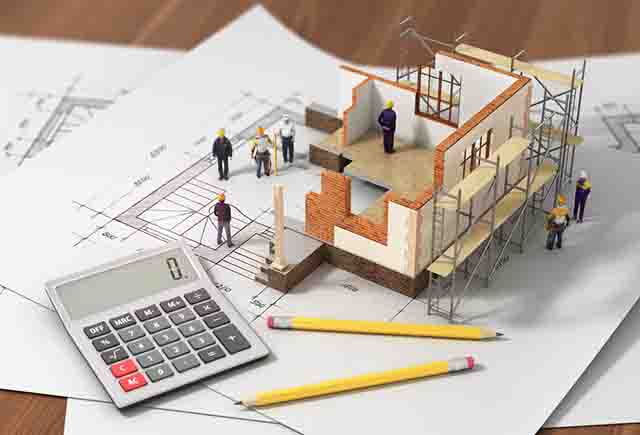Families who own land or live in areas without houses for sale can instead choose to build their own homes. However, they may need a loan to complete the expensive and complicated home-building process.
Most financial institutions offer home construction loans to help families build a house that meets their needs. There are several types of loans, some of which can be turned into mortgages and paid in 15 or 30 years. However, requesting a home construction loan may require more paperwork than a traditional mortgage. In this article, we explain how they work.
What are home construction loans?
Families who prefer to build a house rather than purchase an existing one can request a home construction loan from a financial institution. These loans help them cover the construction costs of a new property. Home construction loans exist because mortgages are only granted to purchase an existing structure.
Unlike mortgage loans, where the entire sum is given in advance to purchase a property, home construction loans assign money in stages using a line of credit as borrowers complete project milestones. Home construction loans usually have periods of up to twelve months and have adjustable interest rates higher than mortgage loans.
In general, most home construction loans have interest rates around 2 percent higher than the prime rate given to customers with excellent credit scores. If the prime rate is 4 percent, borrowers will pay up to 6 percent on their home construction loans. However, borrowers only pay interest on borrowed money rather than the entire amount approved as line of credit. Once the house is built, a home construction loan can turn into a mortgage when owners move in.
To get approved for a home construction loan, borrowers must provide a detailed home building project with a realistic budget and timetable. Some banks only approve applications if borrowers use an accredited builder to build the house. Financial institutions also sometimes require justification as to why building a new home is better than purchasing an existing one. Some families request home construction loans to build a house inside land they own. Others do so because there are no suitable houses for sale in the area.
Borrowers who have their home construction loan requests approved will receive funds according to the timetable presented during the application process. Lenders usually send a representative to check construction progress before approving more money. If construction is going as expected, lenders approve money to cover the following stage. Otherwise, borrowers may face penalties such as delay fees.
One important detail about home construction loans is that borrowers can request money to purchase land where the house will be built if they do not own it. In such cases, the first lump sum of money provided by lenders is used to purchase the land, prepare it and begin construction. However, families who include land purchase in their loan applications must often provide a higher sum of money as down payment.
Construction-to-permanent loans
There are two main types of home construction loans. The first type is called construction-to-permanent loan and works as an unsecured personal loan until the house is built. Once owners move in, a construction-to-permanent loan becomes a mortgage. The main benefit of a construction-to-permanent loan is that families only have to cover closing costs once. This often means saving thousands of dollars that would otherwise be spent in duplicated fees.
Construction-to-permanent loans have two stages. The first stage is active while the property is being built. During this period, monthly payments only cover interest on outstanding balance. This means families can save money while construction takes place.
For example, a financial institution approves a $100,000 construction-to-permanent loan to build a house. To complete the first construction stage, only $20,000 are needed. The bank then transfers that much money to borrowers. During this stage, borrowers will only pay interest on the $20,000 they have borrowed so far, without paying back the principal. If the interest rate is 6.5 percent, monthly interest payments during the first stages would equal around $120. During later stages, when the entire loan amount has been borrowed, monthly interest payments rise to around $350.
The second stage of a construction-to-permanent loan begins once the property has been built. When that happens, the loan becomes a 15 or 30-year mortgage with either fixed or adjustable interest rates. From that moment, the loan behaves like a traditional mortgage, with monthly payments covering both interest and principal. Using the example above, monthly payments would jump from $350 to around $500 for the rest of the mortgage loan term. The newly-built home is used as collateral for the mortgage, and a down payment must be provided. In most cases, financial institutions ask borrowers to provide down payment before construction begins.
Construction-only loans
The second type is called construction-only loan. This type of home construction loan does not become a mortgage once the house is complete and must be paid back in full before people can move in. Construction-only loans are a good choice for families who have significant cash reserves. They are also the optimal choice for homeowners who plan to repay borrowed money by selling their current homes.
Construction-only loans do not require as large a down payment as their construction-to-permanent equivalents. However, lenders have more strict requirements to make sure borrowers repay back their loans, reducing risk of default. In some cases, people may take out a mortgage to repay their home construction loans. As the house is already built, mortgage lenders can issue home loans to simulate a purchase. Families who own a house can use this method to keep cash in hand once their previous property sells.
The main benefit of construction-only loans is their low down payment and additional flexibility. As the house gets built, families can shop for a mortgage loan with generous interest rates and repayment terms. In most cases, construction-to-permanent loans have higher interest rates than traditional mortgages of the same size. As a result, families may end up paying more money down the road by requesting one.
However, construction-only loans have some important disadvantages. First, they often come with higher interest rates than construction-to-permanent loans. Second, borrowers will pay closing costs twice if they decide to get approved for a mortgage. Also, if a family faces financial difficulties and fails to qualify for a mortgage, they risk losing the newly-built house and having their credit scores fall considerably.
How to get a home construction loan
Getting approved for a home construction loan is usually more difficult than requesting a mortgage, especially when it comes to down payment. This is because lenders have no collateral to protect themselves from risk if borrowers default before the house has been constructed. To offset additional risk, most home construction lenders ask for credit scores above 650, no recent history of late payments, stable income source, low debt-to-income ratio and at least 20 percent down payment.
As explained above, lenders also ask for detailed information about the project, including justification as to why buying an existing house is not possible. Also, most lenders only approve home construction loans if an accredited builder is involved in the project. Some banks prefer borrowers who have enough cash reserves to handle any unexpected expenses not accounted for in their proposals.
Finding a home construction loan lender can be challenging. Most financial institutions prefer focusing their businesses on mortgages. Others focus instead on an alternative called “end loan,” in which builders assume construction costs. Once the house is completed, people purchase the house from builders using a traditional mortgage. As most builders are accredited companies, lenders often feel more comfortable issuing end loans.




